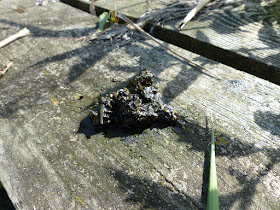After back to back early starts for ringing at the Haven, this morning I opted for a bit of a lie in and headed off to Farlington Marshes at 6:30am for a spot of birding. High tide was at 07:28 and so I started at the lake before walking along the stream and then around the seawall past the Deeps and back to the lake. It was a fantastic morning, absolutely still and glorious sunshine; Langstone Harbour was like a millpond.
The water level on the lake was high and as such the high tide roost was not as I had hoped. There were 150 or so Common Redshank, around 50 Black-tailed Godwits a handful of Dunlin and a single Knot. The stream was not that much better with another 50+ Black-tailed Godwits, a dozen or so Lapwing and single Green and Common Sandpipers.
 |
| Black-tailed Godwit on the Stream Farlington Marshes |
I worked my way around towards the Deeps scanning for an Osprey or something on the sea but my attention was drawn to a couple of pipits on the sea wall that took flight calling just as I got on to them - Tree Pipits, the first of the migrants I had been hoping for. When I got to the Deeps single Whinchat and Northern Wheatear were feeding on the parched ground that normally forms part of the pool.
As I continued around the sea wall towards the point field a bird took of from a fence post and flew along the ditch away from me. I was a bit confused by its identity initially as it flew away from me, but soon the penny dropped, a Short-eared Owl!! I have to admit that I have seen Short-eared Owls many times at Farlington and regularly at the point field, but in August, never. The bird continued to fly away from me circling around the point then heading back along the sea wall north, right past another birder. It landed briefly on the bank then flew back across the point field towards me, but always at a distance, and landed in a bush and out of sight. Despite waiting for a while for it to re-appear it did not.
 |
| Short-eared Owl - Farlington Marshes 9th August 2015 |
 |
| Short-eared Owl - Farlington Marshes 9th August 2015 |
 |
| Short-eared Owl - Farlington Marshes 9th August 2015 |
I don't know when the last record of Short-eared Owl was in Hampshire in August, but suspect that there aren't that many. Regardless of that it was a cracking bird and and is definitely to first record for me in Hampshire in August.



























